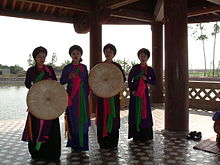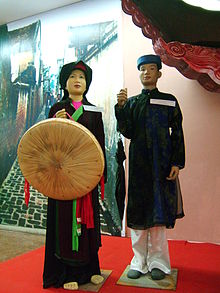Quan họ
- Machine translation, like DeepL or Google Translate, is a useful starting point for translations, but translators must revise errors as necessary and confirm that the translation is accurate, rather than simply copy-pasting machine-translated text into the English Wikipedia.
- Consider adding a topic to this template: there are already 953 articles in the main category, and specifying
|topic=will aid in categorization. - Do not translate text that appears unreliable or low-quality. If possible, verify the text with references provided in the foreign-language article.
- You must provide copyright attribution in the edit summary accompanying your translation by providing an interlanguage link to the source of your translation. A model attribution edit summary is
Content in this edit is translated from the existing Vietnamese Wikipedia article at [[:vi:Quan họ]]; see its history for attribution. - You may also add the template
{{Translated|vi|Quan họ}}to the talk page. - For more guidance, see Wikipedia:Translation.


Quan họ (官賀) singing is a Vietnamese folk music style characterized both by its antiphonal nature, with alternating groups of female and male singers issuing musical challenges and responses. Quan họ is common in rituals and festivals, and a common theme in many songs is love and sentimentality as experienced by young adults.[1] Quan họ river as a UNESCO Intangible Cultural Heritage practice in 2009.[2]
The quan họ style originated in what is now Bắc Ninh Province and was first recorded in the 13th century[citation needed], and has traditionally been associated with the spring festivals that follow the celebration of Tết Nguyên Đán (the Vietnamese New Year). Historically, the singing began on the evening before the festival, but today it is much more common for the singing to occur on the main day of the festival. In general, an initial "challenge phrase" (câu ra) from the known body of songs is sung by a pair of female singers, following which a pair of male singers will respond by selecting and singing a "matching phrase" (câu đối), which must repeat the melody of the challenge phrase. Once they are finished, the order is reversed, and the men will issue their own challenge phrase with a different melody. While in the past the singing was unaccompanied, it is common today for the singers to be accompanied by instruments, whether traditional Vietnamese instruments or modern ones such as electric keyboards.[1]

There are a large number of quan họ melodies, with thousands of different songs having been recorded and written down in score form. A simpler variant of response song, allowing spoken responses and sung by boys and girls at village festivals is trống quân singing.
References
- ^ a b "Quan Họ Singing in Ritual-festivals in Bắc Ninh Region (Vietnam)". Archived from the original on 2003-08-08. Retrieved 2007-07-23.
- ^ UNESCO Culture Sector - Intangible Heritage - 2003 Convention :
External links
- Quan Ho, folk song, MP3, Video
- Quan ho MP3, Video
- Nhac dan ca
- Dan Ca Viet
- v
- t
- e
- Aka polyphony
- Albanian folk iso-polyphony
- Angklung
- Aqyn
- Arabic maqam
- Arirang
- Ashiqs of Azerbaijan
- Azerbaijani tar
- Baul music
- Bećarac
- Bigwala
- Biyelgee
- Bistritsa Babi
- Bumba-meu-boi from Maranhão
- Byzantine music
- Dainichido Bugaku
- Beijing opera
- Candombe
- Cante Alentejano
- Cantonese opera
- Cantu a tenore
- Ca trù
- Cremona violins
- Doina
- Duduk
- Eshuva
- Fado
- Frevo
- Fujara
- Gagaku
- Gagok
- Garifuna music
- Georgian vocal polyphony
- Gong culture
- Guqin
- Gwoka
- Hua'er
- Hudhud chants
- Jongmyo Jereyak
- Iraqi Maqam
- Istrian scale
- Kgal Laox
- Khuumii
- Klapa
- Koodiyattam
- Khorasan Bakhshi
- Kumi odori
- Kunqu
- Lhamo
- Long song
- Maloya
- Meshrep
- Morin khuur
- Mugham
- Muqam
- Nanyin
- Nhã nhạc
- Nongak
- Ojkanje singing
- Pansori
- Pirekua
- Quan họ
- Qudud Halabiya
- Radif
- Reggae
- Rebetiko
- Sama
- Samba de roda
- Seto Leelo
- Shashmaqam
- Silbo Gomero
- Slovácko Verbuňk
- Song of Sana'a
- Sosso Bala
- Sutartinės
- Táncház
- The Song of the Sibyl
- Tumba francesa
- Vallenato
- Vedic chant
- Wayang kulit
- Xi'an guyue
- Xoan singing

 | This Vietnam-related article is a stub. You can help Wikipedia by expanding it. |
- v
- t
- e
 | This article about a music genre is a stub. You can help Wikipedia by expanding it. |
- v
- t
- e










